Our experience with Fumiko in Osaka was great. From the moment we met, she made us feel welcomed and completely at ease. Her energy, and knowledge of the city brought every place we visited to life in a personal and meaningful way.Micheal, Osaka, 2025
Table Of Contents
- The Soul of Osaka's Street Food Culture
- Dotonbori: The Neon-Lit Paradise
- Kuromon Ichiba Market: The Morning Rush
- Shinsekai: Old-School Vibes
- Namba: Shopping Streets Meet Street Food
- Osaka Station Area: Commuter Culture
- Traditional Meets Modern
- Practical Tips for Your Adventure
- International Influences and Markets
- Preserving Tradition While Embracing Change
- Your Osaka Street Food Journey
The Soul of Osaka's Street Food Culture
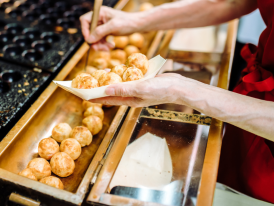
A close-up of sizzling takoyaki being turned on a street grill in Dotonbori.
You know what makes me laugh? Tourists asking me where to find "authentic" Japanese street food in Osaka.
Friend, you're standing in the food capital of Japan – authenticity isn't hiding in some secret alley. It's bubbling, sizzling, and calling your name from every corner.
I've been wandering these streets for three decades, and let me tell you something about the best street food in Osaka: it's not just about the food.
It's about the steam rising from a takoyaki pan at 2 AM, the way vendors shout over the crowd, and how a single bite can make you forget you have a train to catch.
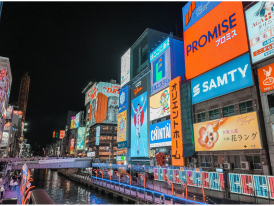
Bustling evening street scene in Dotonbori with neon signs and food vendors.
Osaka didn't earn its nickname "Japan's kitchen" by accident.
Our love for food runs deeper than the Dotonbori river, and our street food vendors are the heartbeat of this foodie city.
While Tokyo gets fancy with presentation, we get down to business with flavor.
The thing about street food in Osaka is that it tells stories.
Every vendor has a history, every recipe carries tradition, and every bite connects you to generations of locals who've perfected these dishes.
You're not just eating – you're participating in a living piece of Japanese cuisine.
Dotonbori: The Neon-Lit Paradise
Start here if you want chaos, crowds, and some of the most legendary street vendors in Japan.
Taste Osaka Like You Live Here
Forget crowded tours. City Unscripted pairs you with locals for a personal, flexible adventure through Osaka’s best bites.
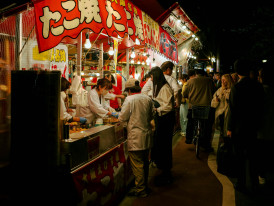
Multiple takoyaki vendors lined up along Dotonbori street with bright signage. Photo by HANVIN CHEONG on Unsplash
Dotonbori street might look like a tourist trap, but here's what the guidebooks won't tell you: some of the best food vendors in Osaka actually set up shop right in the heart of the chaos.
The secret is knowing what to look for.
Look for the stalls near the famous Glico running man sign where vendors have been perfecting their craft for decades.
Watch how they move – the rhythmic turning of each takoyaki ball with metal picks is pure poetry.
The best vendors get that perfect crispy shell while keeping the inside molten and creamy.
The real magic happens with the toppings.
Dried bonito flakes dance on the hot surface, sauce gets drizzled with an artist's precision, and a sprinkle of green onion adds that final pop of color.
Every bite delivers that signature contrast – the slight resistance of the outer shell giving way to the soft, almost liquid center studded with tender octopus.
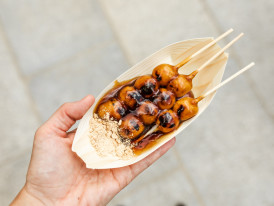
Traditional mitarashi dango with golden glaze.
Walk ten minutes east from the main Dotonbori strip, and you'll find the real gems.
There are small carts that serve incredible mitarashi dango – sweet rice dumplings glazed with a savory-sweet sauce that'll make your sweet tooth sing.
You'll see the vendors grill each dumpling to order.
The outside gets slightly charred while the inside stays chewy.
The mitarashi sauce – a perfect balance of soy sauce, sugar, and mirin – gets brushed on while the dango are still hot, creating this gorgeous lacquered finish.
If you want to eat like locals do, get to kuromon market by 7 AM.
Discover Osaka’s Best Bites With a Local Who Shares Your Taste
City Unscripted matches you with locals who build personal, flexible experiences around your cravings, not a tour group's schedule.
Kuromon Ichiba Market: The Morning Rush
Early birds get the best fish – and I mean really early, like before sunrise early.
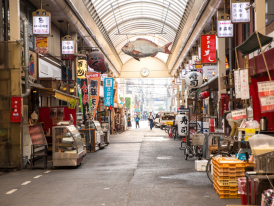
Early morning scene at Kuromon Market with vendors setting up fresh seafood displays.
If you want to eat like locals do, get to kuromon market by 7 AM. This isn't just a tourist destination – it's where Osaka wakes up and fuels up.
The kuromon ichiba market has been feeding this city for over 190 years, and walking through those narrow aisles feels like stepping into Japan's culinary soul.
The fresh seafood here will ruin you for anywhere else. Look for stalls that serve grilled tuna steaks still ruby red in the center.
These vendors char the outside over small charcoal grills, and the smell – that perfect marriage of smoke and sea – draws crowds from blocks away.

Premium wagyu beef being grilled on small hibachi grills Image by Lee Younghee from Pixabay
Here's where things get expensive but totally worth it: the high grade beef stalls. Some vendors specialize in grilled beef that'll cost more than a decent restaurant meal, but the quality is extraordinary.
The marbling on this grilled meat looks like abstract art, and when it hits the grill, the fat renders into pure flavor.
They serve it simply – just salt, maybe a touch of soy sauce – because when you're dealing with meat this good, you don't mess around. Every piece melts on your tongue, releasing layers of rich, buttery flavor.
Shinsekai: Old-School Vibes
This neighborhood feels frozen in time, which is exactly why the food tastes so damn good.
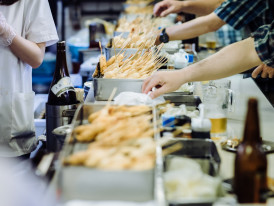
Traditional kushikatsu restaurant with customers standing at outdoor counters.
Shinsekai feels like stepping back fifty years, and that's exactly what makes it special. The neon is dimmer, the streets are grittier, and the dishes are absolutely magnificent.
This is where Osaka-style kushikatsu was born, and the shops here have been perfecting recipes for decades.
The rule is simple: no double-dipping in the communal sauce.
Beyond that, it's a free-for-all of deep fried perfection.
Skewered everything gets dipped in light, crispy batter and fried until golden.
We're talking deep fried shrimp, beef, pork, vegetables, even deep fried tofu – all served piping hot.
The oil temperature is critical – too hot and the outside burns before the inside cooks, too cool and you get greasy kushikatsu.
These guys have it down to a science.
Skip the Lines
Your City Unscripted host knows where locals eat, helping you taste Osaka’s best street food without the crowds.The real treasures in Shinsekai hide in the narrow alleys. Look for tiny takoyaki stands run by husband-and-wife teams that have been there for decades.
No English menus, no tourist photos – just perfect octopus balls and locals who've been coming for years.
These family operations often have different techniques.
Some create takoyaki with slightly different texture – firmer on the outside, almost custard-like inside. The secret is usually in the batter ratio and precise cooking times.
Namba: Shopping Streets Meet Street Food
Business meets pleasure in these covered arcades where salarymen become serious food enthusiasts after dark.
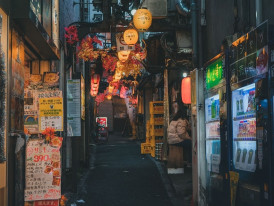
Narrow lantern-lit alley in Hozenji Yokocho with small food stalls. Image by DANG HUYNH SON from Pixabay
Namba station might be all business during the day, but when evening hits, the area changes.
Hozenji Yokocho, a narrow shopping street lined with tiny restaurants and food stalls becomes a street food paradise where salarymen unwind and visitors see the real Osaka.
The okonomiyaki here deserves special mention.
Look for places where they prepare the cabbage pancake with finely shredded cabbage mixed into light batter.
You may already know, but it's not really a pancake at all. It's more like a savory vegetable cake held together with just enough batter to bind it.
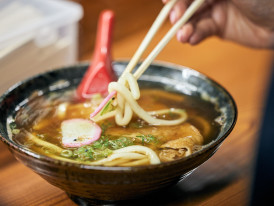
Steam rising from bowls of ramen at a late-night street cart.
After midnight, when trains stop running and the city shifts into a different mood, the ramen carts come out.
These aren't fancy restaurant operations – they're wheeled stalls that set up in specific spots, serving soul-warming bowls to night owls and shift workers.
The ramen at these carts has different character from restaurant versions.
It's heartier, saltier, designed to warm you from the inside and give you strength for the long night ahead.
The broth gets ladled from giant pots that have been simmering for hours, developing layers of flavor you can smell blocks away.
Osaka Station Area: Commuter Culture
Millions pass through here daily, creating a unique ecosystem of lightning-fast, incredibly satisfying street food.
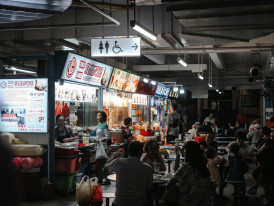
Busy underground food court near Osaka Station with multiple vendors.Photo by Cameorn Steele on Unsplash
The area around the super-busy station station isn't just about catching trains – it's about catching meals on the go.
The underground levels house incredible Osaka street food vendors who cater to thousands of commuters passing through daily.
There are sushi counters that serve some of the freshest fish outside major markets.
These chefs source directly from suppliers who also serve high-end restaurants.
But instead of white tablecloths and reservations, you eat standing at small counters, watching them work their magic.
The sushi here isn't fancy – no exotic preparations or unusual ingredients. Just perfectly seasoned rice topped with pristine fish.
The tuna melts on your tongue, the yellowtail has that clean, oceanic flavor, and the salmon practically glows with freshness.
Quick Bites for Busy Lives
The genius of street food near train stations is how it adapts to urban life.
Everything is designed for speed without sacrificing quality. Karaage chicken vendors have their timing down to perfection – each piece spends exactly three minutes in oil, coming out golden and crackling.
There are also mitarashi dango carts that have become legendary among commuters.
Vendors grill the rice dumplings while you wait, brushing them with that glossy sweet-savory sauce. They're served on wooden skewers, perfect for eating while walking to catch connections.
Traditional Meets Modern
Watch old masters work alongside young innovators – both creating magic, just with different techniques.
Eat Osaka's Best, Away From the Crowds
City Unscripted locals craft personalized food adventures just for you. No clichés, just authentic bites.
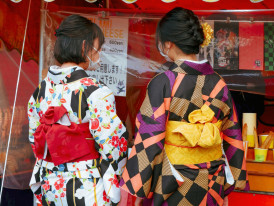
Traditional food vendors near Sumiyoshi Taisha shrine with ceremonial decorations.Photo by Susann Schuster on Unsplash
Near ancient shrines like Sumiyoshi Taisha, street foods take on more traditional character. The vendors here have been serving temple visitors for generations, and their recipes reflect deeper connections to Japanese food culture.
The traditional sweets here tell stories of seasons and ceremonies.
During cherry blossom season, you'll find sakura mochi – pink rice cakes wrapped in pickled cherry leaves.
The leaves aren't just decoration; they add subtle floral flavor and slight saltiness that balances the sweet rice.
Look for taiyaki vendors who've been in the same spots for decades.
Their fish-shaped pastries filled with sweet red bean paste are works of art. The batter gets poured into fish-shaped molds, filling added with precision, then more batter to seal it. The result is a crispy shell giving way to warm, sweet filling.
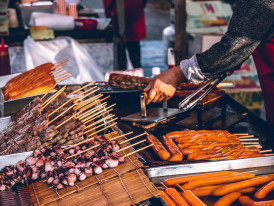
Modern Chuo Ward street food vendor combining traditional Japanese techniques with international flavors.Image by Hitesh Choudhary from Pixabay
While tradition remains strong, Osaka's street food scene continues evolving.
Young vendors in Chuo Ward are taking classic techniques and applying them to new ingredients and flavor combinations, creating exciting fusion dishes that still respect Japanese cuisine fundamentals.
Some vendors in Chuo Ward now make ramen burgers – using compressed ramen noodles as "buns" and filling them with traditional Japanese ingredients.
It sounds gimmicky, but when executed well, it's brilliant.
The noodle patties get pan-fried until crispy outside, staying chewy inside.
Practical Tips for Your Adventure
Three decades of street eating taught me these tricks that'll save you time, money, and embarrassment.
More than 26,287 5-star reviews and counting
26,287+ 5-Star Reviews and Counting
Trusted and recommended by travelers worldwide.
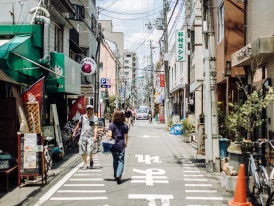
Early morning food vendors setting up before the daily rush.
Timing makes all the difference in experiencing the best street food Osaka has to offer. Early morning (6-8 AM) is perfect for markets and commuter areas.
You'll find the freshest ingredients and vendors who are energized for the day ahead.
Lunch hours (11 AM - 2 PM) bring different energy. Business districts buzz with activity, shopping streets fill with families, and vendors hit their peak.
This is when you'll see the most variety and highest volume of preparation.
Evening (5-9 PM) changes the scene entirely.
The pace relaxes, alcohol appears, and vendors who specialize in dinner dishes set up shop. The atmosphere becomes more social, with more interaction between vendors and customers.
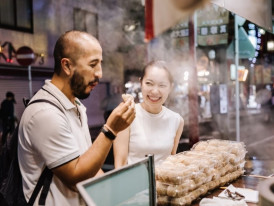
Respectful interaction between foreign visitors and local food vendors.
Eating street food here comes with unwritten rules that enhance the experience for everyone.
Most vendors appreciate when customers show interest in the preparation process, but avoid blocking other customers or interfering with work.
Payment is typically cash-only, and having exact change makes transactions smoother.
Many vendors speak limited English, but pointing and simple gestures work perfectly.
Learning basic words like "arigato gozaimasu" and "oishii" goes a long way.
One beautiful thing about street foods in Osaka is how it makes incredible flavors accessible to any budget.
You can eat exceptionally well for very little money, or splurge on premium ingredients without breaking the bank.
Taste Osaka Like a Local, Not a Tourist
City Unscripted connects you with locals who craft flexible, personal experiences tailored to your tastes.
International Influences and Markets
Osaka's global soul shows up in unexpected places, creating fusion food that somehow makes perfect sense.

Korean-Japanese fusion dish. Photo by Markus Winkler on Unsplash
Osaka's position as an international city means Osaka street food incorporates influences from around the world, but always through a Japanese lens.
Korean-Japanese fusion is particularly popular, reflecting the large Korean community in the city.
Some vendors make incredible Korean-style pancakes using Japanese ingredients.
The pajeon gets made with local green onion and fresh seafood from nearby markets, but cooking techniques and seasoning reflect Korean traditions.
Market Culture Beyond Kuromon
While kuromon market gets most attention, smaller fish markets throughout the city offer incredible Osaka street food experiences.
These neighborhood markets serve locals first, tourists second, which means you'll find better prices and traditional preparation methods.
Vendors at these smaller markets often specialize in one or two dishes, perfecting them over decades.
You'll find the best grilled seafood skewers at these spots, where vendors brush them with sauces that combine traditional miso with contemporary flavors.
Preserving Tradition While Embracing Change
The best vendors balance respect for the past with smart adaptations for today's hungry crowds.
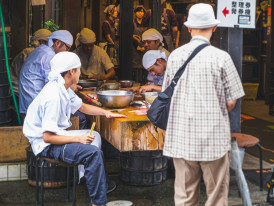
Elder vendor teaching younger family member traditional street food preparation techniques. Photo by Luca Dal Molin on Unsplash
Despite modernization and tourist pressures, many vendors remain committed to preserving traditional methods and recipes.
Family businesses pass down techniques through generations, maintaining connections to Osaka's culinary heritage.
This preservation happens not just in recipes, but in relationships.
Long-term vendors know their regular customers' preferences, remember family members, and maintain social connections that make the experience about more than just commerce.
I've seen how new vendors bring fresh energy and ideas while respecting established traditions.
They're finding ways to make traditional dishes more accessible to international visitors without compromising what makes it unique.

Satisfied visitors and locals sharing a meal together at street food stalls as the sun sets over Osaka. Photo by cottonbro studio: https://wwpexels
The best street food in this city isn't found through rankings or reviews – it's discovered through exploration, curiosity, and willingness to follow your nose and instincts.
Every vendor has a story, every dish connects to tradition, and every bite offers a chance to understand this remarkable city a little better.
Start with famous spots if you want, but don't stop there. Wander the shopping streets, explore different wards, eat at different times of day.
Talk to locals, watch vendors work, and pay attention to where people from Osaka choose to eat.
For more inspiration on exploring this incredible city, check out our guide to Osaka experiences and discover the best things to do in Osaka.
This is your invitation to explore, to taste, and to discover why locals like me never get tired of Osaka's incredible street foods culture.
The city is waiting, the vendors are ready, and your taste buds are about to go on the trip of a lifetime.
One City. One Local. Your Personal Kyoto Adventure.
SEE KYOTO EXPERIENCESExplore Kyoto Through the Eyes of Someone Who Shares Your Pace
City Unscripted matches you with locals who create flexible, personal experiences designed for slow discoveries, not group tours.
Chat With a Tokyo Local Who Understands You
Get your questions answered by someone who knows Tokyo inside-out. No pressure, just honest tips from locals who understand your style.








